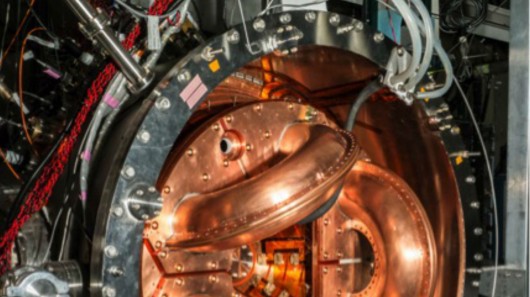University of Washington fusion reactor promises "cheaper than coal" energy
By David Szondy
October 12, 2014

The University of Washington's HIT-SI3 experimental reactor (Photo: University of Washington)
In the 21st century, the world lives with two futures ahead of it Ė one of looming energy shortages, and another of godlike energy abundance. The key to this whether itís possible to turn fusion reactor technology from a laboratory exercise into a real-world application. Engineers that the University of Washington (UW) are working on a fusion reactor that, when scaled up, could produce energy on a practical scale, yet at a cost rivaling that of a conventional coal-powered plant.
Nuclear fusion, as the name implies, is based on fusing hydrogen atoms to form helium; a process that releases tremendous amounts of energy. According to science writer Ben Bova, a single glass of water could produce as much energy as half a million barrels of petroleum. It would also be safer than current nuclear plants that rely on splitting heavy atoms, there would be no chance of a meltdown or spewing radioactive fuel into the air, and very little radioactive waste. And since it uses hydrogen as fuel, there would be enough to last until the end of time.
Long term, its looks brilliant, but at the moment itís a hopeless non-starter thatís too impractical and too expensive to leave the laboratory. With the exploding of the first hydrogen bomb in the 1950s, fusion reactors seemed around the corner, and they were predicted to be in common use in 25 years time. Unfortunately, that kept being the case and remains so today; fusion power is always 25 years away.
To recreate fusion on Earth without using atomic weaponry, a machine needs to be built that can recreate the conditions inside the Sun, which is basically a giant fusion reactor. That means a container that hot enough and under enough pressure for the fusion process to start. Though fusion reactors were built over fifty years ago and a bench-top version was featured at the 1964 New York Worldís Fair, producing a reactor that went beyond the experimental and into the practical remains elusive.
Part of the problem is to balance the energy equation. Getting hydrogen to fuse is one thing. Getting it to do so while producing more energy than you pump into the reactor to run it is another. Even if you manage that, you still need to generate that energy at a low enough cost to compete with conventional sources.
The main contender for winning that prize at the moment is ITER; an international project to produce a practical fusion reactor. Located in Cadarache, France, the ITER reactor is a joint venture between the United States, the EU, India, Japan, South Korea, China, and Russia.
It uses a tokamak design. that is, a giant torus surrounded on the sides and in the core by superconducting magnets generating tremendous energy. These create a magnetic field inside the torus that squeezes together, contains, and heats hydrogen into a plasma, which at the right temperature and pressure start to fuse. Itís a very advanced technology and brings us closer to the fusion age than ever, but it still a long way from the finish line. Though still under construction, the economics if ITER donít look good with cost per kilowatt well outside of what conventional sources can produce.
The UW approach has more modest roots as a project in a 2012 class taught by Thomas Jarboe, a UW professor of aeronautics and astronautics and an adjunct professor in physics, and later taken up by Jarboe and doctoral student Derek Sutherland. Called Dynomak, the new concept reactor is simpler than ITER by a factor of ten, yet has the potential of making more energy at less cost.
According to the UW team, Dynomak builds on existing technology, such as an ITER-developed cryogenic pumping system. Technically, its a spheromak, which means that instead of a torus, itís a simple oblate spheroid. Thereís no central core and it doesnít need the large, complex superconducting magnets that ITER uses. Instead the magnetic fields are produced by putting electrical fields into the center of the plasma using high temperature superconducting tapes wrapped around the vessel, so, in a sense, the plasma contains itself.
According to the UW team, this means the Dynomak is smaller simpler, and cheaper to build, yet produces more power than the ITER reactor. Also, since the plasma heats itself, the fusion reaction is self-sustaining as excess heat is drawn off by a molten salt blanket to boil water to run a steam turbine to generate electricity.
If the UWís calculations are correct, a Dynomak reactor would cost a tenth of ITER and produce five times as much energy at an efficiency of 40 percent. that means that a one gigawatt Dynomak power plant would have a total cost of US$2.7 billion against the US$2.8 billion needed to build a coal plant
The UW team says that the current Dynomak is only ten percent of the size and power of a practical reactor, which years away in terms of development. However, they say that the test reactor has so far demonstrated its ability to sustain a plasma and they plan to increase the temperature and power output of the unit.
"Right now, this design has the greatest potential of producing economical fusion power of any current concept," says Jarboe.
The UW teamís findings were published in Fusion Engineering and Design.
Source: University of Washington
copyright © Gizmag 2003 - 2014
http://www.gizmag.com/dynomak-fusion-reactor-university-washington/34174